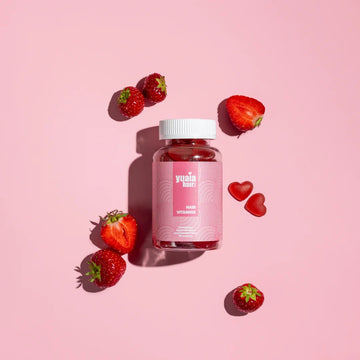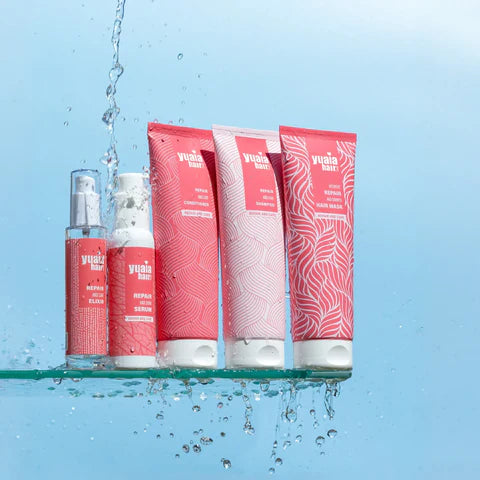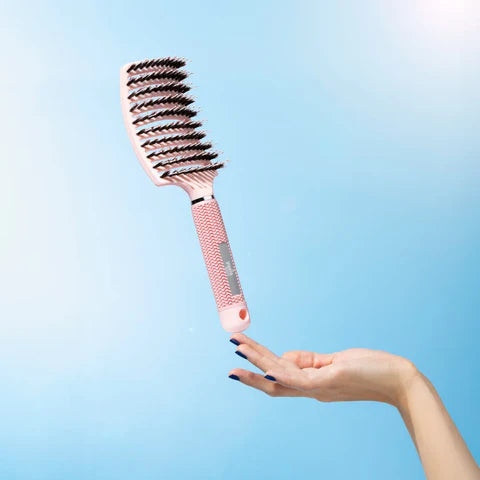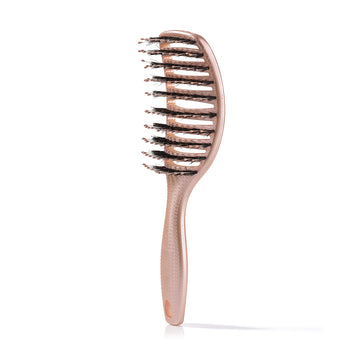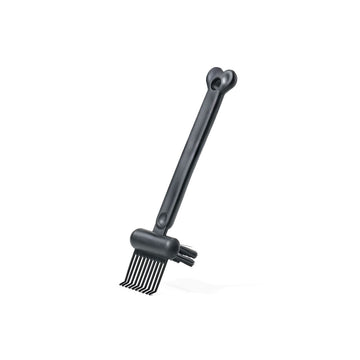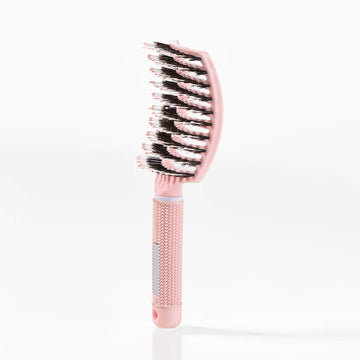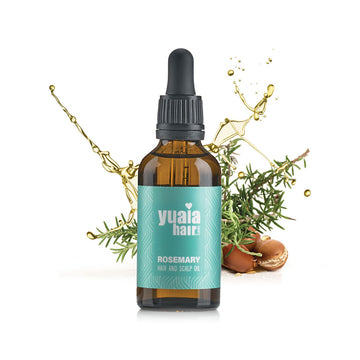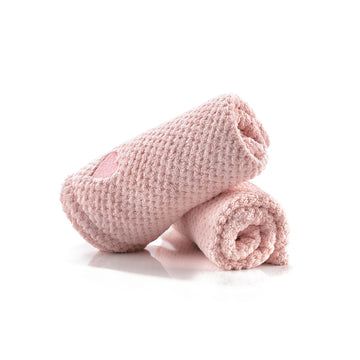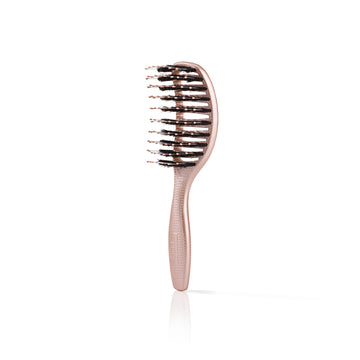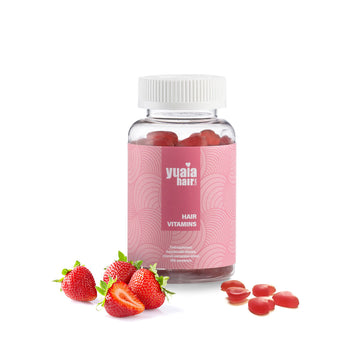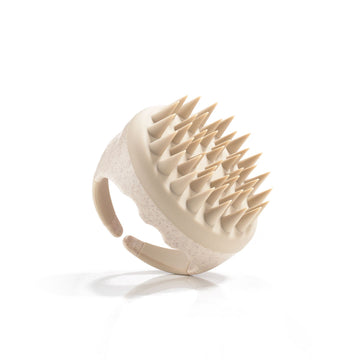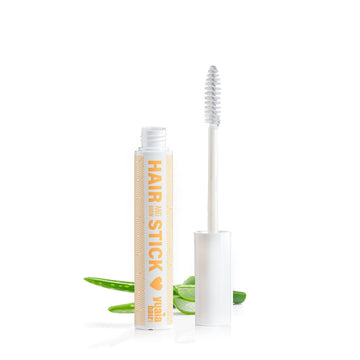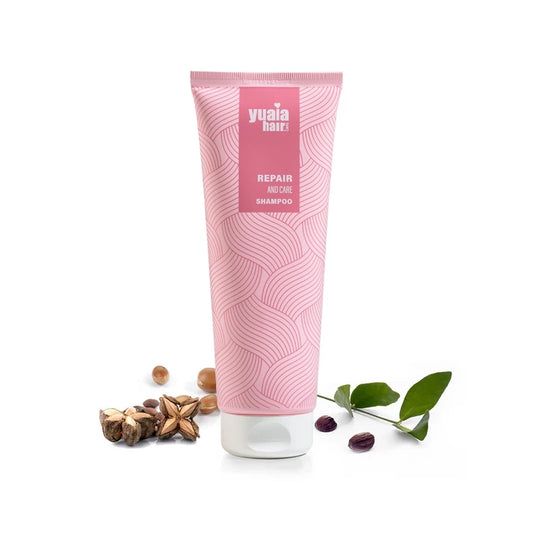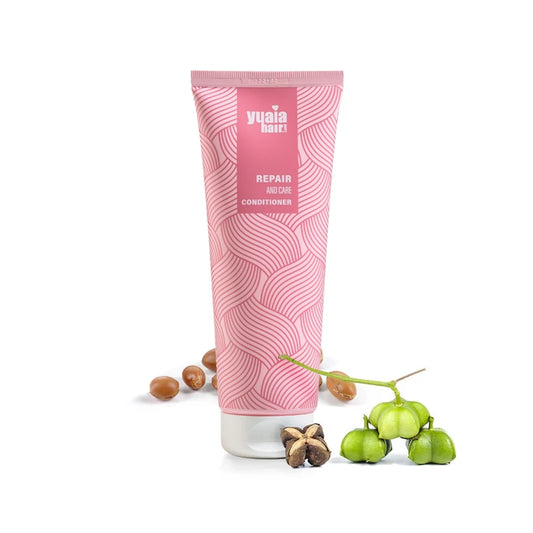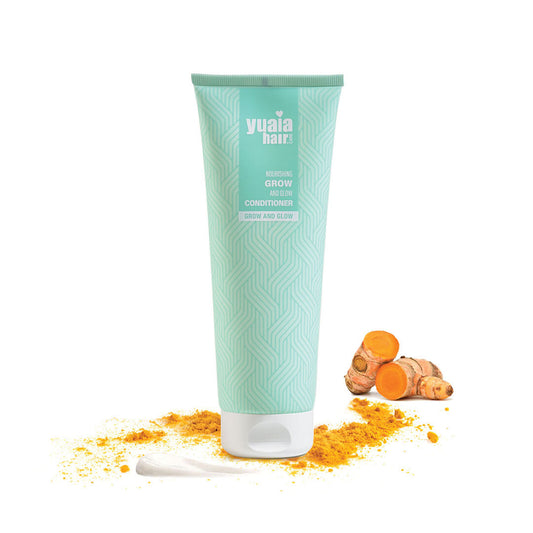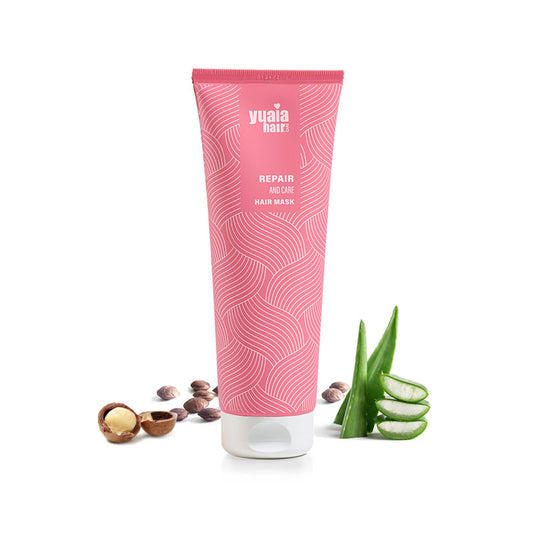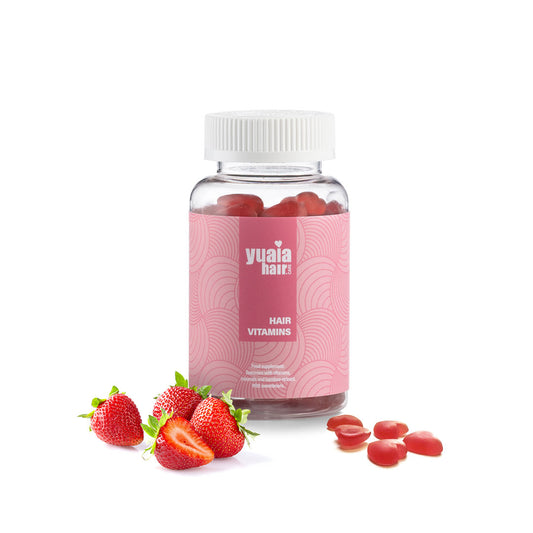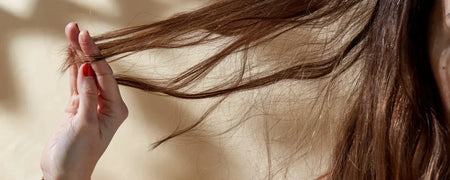
Types of hair porosity
Low Porosity hair - Hair with low porosity has a dense and flat scale structure, making it difficult for moisture to penetrate. It requires products with light and water-based ingredients to avoid product residue build-up and provide adequate hydration. Choosing humectant ingredients, like aloe vera or glycerin, can also help attract moisture into the hair without weighing it down.
Medium Porosity hair - Hair with medium porosity has a balanced scale structure that allows moisture to penetrate without problems. It can benefit from a wide range of hair products, but still needs to be aware of the correct balance between protein and moisturizing treatments.
High Porosity hair - Hair with high porosity has an open scale structure that quickly absorbs moisture. This can lead to excess frizz and hardness in the hair. High porosity hair benefits from products with intense hydration as well as protein treatments are necessary to repair the damaged hair structure and retain moisture for a longer time. Using leave-in conditioners and sealing oils can also help lock in moisture.
What is low porosity hair?
Characteristics of low porosity: Low porosity hair is characterized by its dense and compact structure, which makes it difficult to absorb and retain moisture. This type of hair tends to develop build-up from oils and other hair products quickly, as it struggles to let moisture in. Knowing your hair’s porosity can be incredibly beneficial since it helps you select products that cater to its unique needs. For low porosity hair, choosing the right products means better absorption of care ingredients, improved moisture retention, and greater control over frizz and flyaways.
Produkt tips for low porosity hair: To care for low porosity hair, light, water-based products are recommended to avoid weighing the hair down. Moisturizing leave-in conditioners with humectants like aloe vera or glycerin are especially effective, as they attract moisture and help enhance the hair’s hydration without creating build-up.
What is medium porosity hair?
Characteristics of medium porosity: Medium porosity hair has a moderate ability to absorb and retain moisture. It can be resistant to styling products and has a balance between elasticity and durability.
How does medium porosity hair affect your styling options? Medium porosity hair allows you to experiment with different hairstyles as it is more flexible than low porosity hair. It also absorbs products better and holds curls or waves for longer.
Product tips for medium porosity hair: To maximize results with your medium porosity hair, use light, water-based products that won't weigh it down. Avoid heavy oils or wax-based formulations as they can make hair greasy or sticky. Also use regular deep cleansing shampoo to remove product build-up without drying out the hair.
What is high porosity hair?
Characteristics of High Porosity: Hair with high porosity tends to absorb moisture quickly, but it also loses the same moisture quickly. This often results in dry and frizzy hair as well as weakened elasticity.
"Problems" associated with hair closure and how to fix them: Hair with high porosity can have problems such as over-absorption of products, making it difficult for nourishing ingredients to penetrate the hair. To solve this, it can be good to use lightweight products and avoid heavy oils or creams.
Best products for caring for high porosity hair: Some of the best products for caring for high porosity hair include moisturizing shampoos, conditioners and leave-in conditioners. It is also important to use a deep treatment regularly to rebuild the hair's structure and reduce porosity.

Effects of hair porosity
Hair porosity can have a significant impact on the hair's ability to absorb moisture. Low vs high porosity hair react differently to moisture and products, so understanding your porosity level is key to effective hair care. The more porous the hair, the faster it absorbs moisture from the environment and products, which can lead to dryness and frizz. It is important to choose hair products that are specially formulated to improve and maintain moisture levels in porous hair.
Porous hair also has difficulty retaining moisture. Because the scales on the porous hair do not lie completely flat, they cannot prevent water molecules from escaping the hair again. This results in dryness and lack of shine. Using products with intensive moisturizing properties and subsequently sealing the cuticle layer will contribute to a more hydrated result in porous hair.
How does porosity affect the hair's ability to absorb moisture?
Porosity plays a crucial role in the hair's ability to retain moisture. Hair with high porosity tends to absorb moisture quickly, but also lose it just as quickly. On the other hand, low porosity hair may have difficulty absorbing moisture effectively. In order to maintain optimal moisture balance, it is important to use care techniques that suit the hair's porosity level.
To maintain an optimal moisture balance, it's important to adapt care techniques to each hair porosity level:
- Low Porosity Hair: Use lightweight, humectant-based products and apply heat during conditioning to help the cuticle open and absorb moisture.
- Medium Porosity Hair: A balanced routine with regular conditioning and occasional deep treatments can help maintain moisture without overloading the hair.
- High Porosity Hair: Regular use of deep conditioners, protein treatments, and sealing oils can help retain moisture and reduce frizz.
- Understanding these differences allows you to tailor your hair care routine for better moisture retention and overall hair health.
How does porosity affect the hair's ability to retain moisture?
Color technology and hair porosity play a decisive role in the hair's ability to receive and retain color. Porous hair absorbs the dye faster, which can result in a deeper and more intense color. But it can also lead to uneven coloring and shorter durability of the color due to increased pigment leaching. For better results, it is recommended to use products specially designed for porous hair that contain moisturizing ingredients to help keep the color longer. Read more about hair color here .
Tips for coloring different types of porous hair:
- For low porosity hair: Use heat during the treatment improves the absorption of the dye.
- For medium porous hair: Using a pre-color treatment can help balance the hair's structure before dyeing.
- For high porosity hair: Gradual application is key, starting with the most damaged areas and working your way up gradually rather than evenly

How does porosity affect the hair's ability to receive and retain color?
Color technology and porosity play a decisive role in the hair's ability to receive and retain color. Porous hair absorbs the dye faster, which can result in a deeper and more intense color. But it can also lead to uneven coloring and shorter durability of the color due to increased pigment leaching. For better results, it is recommended to use products specially designed for porous hair that contain moisturizing ingredients to help keep the color longer. Read more about hair color here .
Tips for coloring different types of porous hair:
- For low-porosity hair: Use heat during the treatment improves the absorption of the dye.
- Using a pre-color treatment can help balance the hair's structure before dyeing.
- For high-porosity hair: Gradual application is key, starting with the most damaged areas and working your way up gradually rather than evenly
Recommended hair products for different porosities
Hair porosity plays an important role in choosing your hair products. For low porosity, light products such as oils and leave-in conditioners are recommended. For medium porosity hair, it is best to use moisturizing shampoo and conditioner as well as protein treatment once a week. High porosity requires products with intense moisture and nourishment, such as deep-acting masks and oil treatments to repair damaged hair. It is important to choose the right products for your hair type in order to achieve the desired effect on your hair.
Low porosity
For low porosity hair, it's best to use light, water-based conditioners with moisturizing properties that can penetrate the tightly packed cuticles without causing buildup. Lightweight leave-in conditioners are also ideal, as they help maintain a balanced moisture level without overwhelming the hair or leaving it feeling greasy.
Coconut oil or a conditioner can be beneficial for pre-poo treatments to enhance hydration before washing, especially when applied with gentle heat to help open the cuticle layer and increase absorption. This combination of light conditioning and strategic pre-wash treatments provides the hydration low porosity hair needs without weighing it down.
Medium porosity
Medium porosity hair has a moderate ability to absorb and retain moisture, which gives it a balanced texture but still makes it vulnerable to damage from chemical treatments or frequent heat styling. To keep medium porosity hair healthy, it’s important to use moisturizing products that don’t weigh it down.
Lightweight balms and serums are excellent choices, as they nourish the hair without creating a heavy feel. Protein-based shampoos and conditioners are also beneficial, as they help strengthen the hair while maintaining its structure. Using a leave-in conditioner can add extra moisture, and applying thermal protection before any heat styling helps prevent potential damage to the hair’s structure, preserving its smooth surface and elasticity.
High porosity
High porosity hair absorbs products rapidly but struggles to retain moisture, often leading to dryness, frizz, and breakage. To protect highly porous hair and prevent damage, it’s essential to use products that deeply nourish and seal in hydration.
Leave-in conditioners are particularly effective as they provide lasting moisture and create a protective barrier against moisture loss. Low molecular weight oils, such as argan or grapeseed oil, can help seal the cuticle and lock in moisture without feeling too heavy. Protein treatments are also beneficial for strengthening hair fibers and rebuilding the hair’s structure, helping to reduce porosity over time and enhance overall resilience.
How to determine your hair porosity with tests
Hair porosity is an important factor to consider when choosing your hair products. To determine your hair porosity, you can perform three simple tests: the Float test, the Slide test and the Spray test. These tests help determine whether your hair has low, medium or high porosity, which will affect which products are best for your hair.
Float testing
The float test is a simple but effective way to determine the porosity of your hair. To perform the float test, place a clean strand of hair in a bowl of water and observe what happens. Here are some indications you can get from the float test:
- If the hair floats on the surface, it has low porosity, meaning the hair has a tightly bound cuticle layer that resists moisture absorption.
- If the hair sinks slowly to the bottom, this suggests normal or medium porosity, where the cuticle structure allows for balanced moisture absorption and retention.
- If the hair sinks quickly or immediately reaches the bottom, it indicates high porosity, suggesting an open or damaged cuticle layer that absorbs moisture rapidly but also loses it quickly.
Depending on the result of your float test, you can adjust your hair products for optimal care. Here are some guidelines based on the porosity level:
- Low Porosity:
- Use light and moisturizing products to avoid build-up and heaviness.
- Avoid heavy oil and products with proteins.
- Normal Porosity:
- Choose products according to your specific needs, such as focusing on volumizing or moisturizing.
- Use regular conditioners and deep treatments.
- High Porosity:
- Focus on repair and strengthening with protein-rich products.
- Avoid heat styling and other factors that can increase wear.
Always remember to adapt your routine based on your own hair and experiment with different products to find the perfect balance. The float test can be a useful tool to understand your hair's porosity and make more informed care decisions.
The Slip ‘n slide test
The Slip ‘n Slide test, also known as the Slide test, is a straightforward method to evaluate hair porosity by examining the texture of your hair strand. Here’s how to perform it:
To begin, take a single strand of clean, product-free hair. Gently slide your fingers up the strand from the tip towards the root. If the strand feels smooth as you move up, this typically indicates low porosity, where the hair cuticle is tightly sealed, making it harder for moisture to penetrate.
If the strand feels somewhat rough or has slight bumps, this suggests medium or normal porosity, as the cuticle is slightly raised but still retains moisture fairly well. However, if the hair strand feels very rough or bumpy, this is characteristic of high porosity hair, where the cuticle layer has more gaps, allowing moisture to escape easily after absorption.
The spray test
The Spray test, also known as the Water test, is another way to determine hair porosity. Start by selecting a small section of clean, dry hair and giving it a light spritz of water.
When you spray some water on a section of your hair, you will be able to observe how the hair reacts.
- If the water beads up on the surface, this indicates low porosity hair. Low porosity hair resists water absorption, which causes the water to sit on top rather than penetrate.
- If the water absorbs slowly, this suggests medium or normal porosity, where hair absorbs water at a moderate rate and retains moisture well.
- If the water soaks in quickly, this is a sign of high porosity hair. High porosity hair rapidly absorbs moisture but may lose it just as quickly, often leading to dryness and frizz.
By knowing the porosity of your hair, you can choose the right products to care for it effectively.
Frequently Asked Questions
What is hair porosity and why is it important?
Hair porosity refers to your hair's ability to absorb and retain moisture. Understanding your hair's porosity is important because it helps you choose the right products and care techniques for optimal hydration, strength, and manageability.
How can I test my hair's porosity at home?
You can test your hair's porosity using the float test (placing a clean strand of hair in water), the slide test (feeling the texture of a strand from tip to root), or the spray test (spraying water on a section of hair and observing how quickly it absorbs).
What products are best for low porosity hair?
Low porosity hair benefits from lightweight, water-based products and humectants like aloe vera or glycerin. Avoid heavy oils and protein-rich products, as they can cause buildup and weigh the hair down.
How does high porosity hair differ from low porosity hair?
High porosity hair absorbs moisture quickly but loses it just as fast, often leading to dryness and frizz. Low porosity hair resists moisture absorption, making it harder for products to penetrate. Each type requires different care routines and products for best results.
Can hair porosity change over time?
Yes, hair porosity can change due to factors like chemical treatments, heat styling, environmental exposure, and aging. Regularly assessing your hair's porosity can help you adjust your hair care routine as needed.
 2-5 day delivery
2-5 day delivery
 25.000+ satisfied customers
25.000+ satisfied customers
 Satisfaction Guarantee
Satisfaction Guarantee

